Regional economy. Рубрика в журнале - Economic and Social Changes: Facts, Trends, Forecast
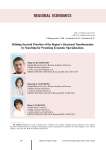
Статья научная
Global crises and foreign trade restrictions imposed on the Russian economy slow down its growth, affecting export-oriented regions to a great extent. Retaliatory economic measures, including those aimed to promote structural transformation of the economy, require its key directions to be defined. We attempt to determine priorities of the structural transformation of the Vologda Oblast economy by searching for promising types of economic activity. For this purpose, we study theoretical foundations of the search for priorities of sectoral development, elaborate and test a methodological approach to the search for promising branches of regional economic specialization, and identify areas of development for potential growth points. Using the materials of the Vologda Oblast, we make a list of activities whose development is promising from the point of view of long-term economic growth and identify potential opportunities for their introduction into the region’s economy. Scientific novelty of our work consists in the development and testing of our own tools for finding priorities for the structural transformation of the regional economy based on identifying promising economic specializations. The information base includes works of Russian and foreign researchers in the field of industrial and spatial development, data from state statistics, the Federal Institute of Industrial Property, scientific electronic library eLIBRARY. ru and regional input-output tables for the Vologda Oblast. The findings of the work can be used in the management of the region’s sectoral and spatial development and in research on the issues under consideration.
Бесплатно
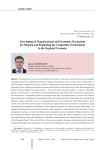
Статья научная
The processes of economic development of countries, industries, and enterprises are necessarily accompanied by the competition between the subjects of economic activity. That is why it is important to create favorable conditions for them, to form a competitive environment that meets market principles of economic activity, taking into account minimum intervention of the government in the functioning of the market. Russia is inferior to many countries - even to the former Soviet republics - in terms of favorable business environment; it ranks 40th in the Doing Business rating. Since there is no system approach to the formation of a competitive market environment and state competition policy is carried out with the help of economic coordination of economic entities, it becomes relevant to determine the set of elements (subjects, objects, methods, tools, etc.) regulating this area, and to study the links between them. Based on this, the goal of the present study is to develop an organizational and economic mechanism to shape and regulate the competitive environment in the regional economy...
Бесплатно
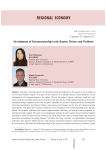
Development of entrepreneurship in the region: drivers and problems
Статья научная
The paper examines drivers of entrepreneurship development in the region on the example of Ural Federal District regions. The goal of the research is to identify drivers of and problems in the development of entrepreneurship in the region. We use theoretical, logical, statistical, analytical, and index methods. Scientific novelty of the study lies in the fact that it considers global experience of research entrepreneurship as applied to the level of region, identifies sets of factors that promote the development of entrepreneurship in the Tyumen Oblast, and assesses their impact on the level of entrepreneurship development. The paper also considers problems in the development of entrepreneurship in the Tyumen Oblast. We propose indicators that assess implementation efficiency of regional (state) programs for entrepreneurship support. We carry out a comparative analysis of some aspects of governmental support provided to small business in some countries. By 2016, Russia has made a breakthrough and improved economic environment for doing business, but there has been a decline in institutional environment indicators...
Бесплатно
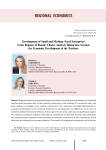
Статья научная
Regional economic processes determine the scale of functioning and performance of small and medium-sized enterprises due to their specific involvement in the economy of a territorial entity and quick response to changes in the external environment. The unevenness and high differentiation of economic development in the territories determine the heterogeneity and differences in the level of entrepreneurship development in Russia. In this regard, the aim of our study is to arrange Russian regions into clusters according to indicators reflecting the development of small and medium-sized enterprises and macroeconomic parameters characterizing the economic environment of their functioning, which either acts as a driving force or creates obstacles. The novelty of the approach consists not only in the fact that it integrates enterprises’ development indicators and indicators of the external economic environment of their functioning into the clustering parameters, but also in the formation of final clusters, taking into account the grouping of regions for each year of the period under consideration. This makes it possible to determine the stability of the territory in the group or to track the movement between groups. The k-means method is chosen for clustering. Clustering was carried out according to Federal State Statistics Service data from 2015 to 2021 in 85 regions of Russia. Five clusters have been obtained, whose features confirm the assumption that the development of small and medium-sized enterprises is determined by the economic development of the territory as an external environment of their functioning. Nevertheless, a special second cluster was identified, with the presence of restrictions on the use of the potential of the economic environment, which includes regions that differ in the average level of development of small and medium-sized enterprises against the background of high economic development. The results obtained can be used in the elaboration and implementation of policies to improve the sphere of small and medium-sized businesses at the level of the state as a whole and at the level of a particular region. Further development of our findings may consist in changing indicators or including other clustering algorithms, further typologizing regions or conducting correlation and regression analysis within individual clusters.
Бесплатно
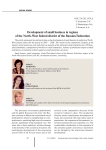
Статья научная
The article represents the statistical data on the development of small business in subjects of North-West federal district for the period of 2003 - 2008. The results of the comparative analysis of the region’s achievements on such indicators as quantity of the registered small enterprises per 100 thousand inhabitants, employment of workers on small enterprises, volumes of production output at small enterprises, investments in fixed capital at small enterprises are given.
Бесплатно
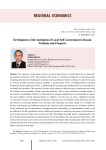
Development of the institution of local self-government in Russia: problems and prospects
Статья научная
The relevance of the article is due to the active discussions of a draft federal law on local selfgovernment in Russia in 2022. The purpose of the work is to identify prerequisites for and substantiate promising directions of reforming the institution of local self-government in Russia. To achieve the goal we use key general scientific research methods, a questionnaire survey of Vologda Oblast municipal formations’ heads conducted in 2022, a methodology for grouping municipalities by level of development to identify the specifics of the answers of heads in the context of different types of territories and reveal the attitude of municipalities’ heads toward the draft law. This is what constitutes scientific novelty of the study. It is established that the low financial and economic independence of municipalities remains the main problem of local self-government. In addition, over the past ten years a significant number of constituent entities of the Russian Federation witnessed cases of abolition of the settlement level of government as municipal districts were converted into municipal and urban okrugs. It is revealed that the key controversial and ambiguous points in the draft law under consideration are as follows: abolition of the settlement level of government; strengthening the responsibility of municipalities’ heads to the top official of the RF constituent entity; insufficient attention to specifying the powers and functions of local self-government bodies and resources for their full-fledged and high-quality implementation. We put forward recommendations for improving the text of the draft law for each aspect specified above. The results of the research can be used in the work of federal authorities when finalizing the draft law on local self-government and in the practical implementation of the new reform; they can also serve as a basis for further research on this topic.
Бесплатно
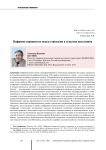
Digital inequality between urban and rural population
Статья научная
Digitalization can transform social inequality between urban and rural population into a digital divide. This issue in the “city-village” context is not given due attention by scholars and is mainly limited to the country level. Interregional inequality in scientific publications is considered, as a rule, outside of this context. The study seeks to eliminate this gap. The aim is to identify features, trends and quantitative parameters of digital inequality (divide) between urban and rural population at the national and interregional level and identify ways to address the issues that arise. The tasks are to establish trends in the formation of a digital divide in the levels of Internet access and digital competence of users, in obtaining state and municipal services and ordering goods/services; to assess the reasons for the rural population's refusal to use the Internet and identify ways to solve this problem. The study was based on a combination of calculation of coefficients ofvariation and grouping of regions. We used the data of the federal statistical observation.
Бесплатно
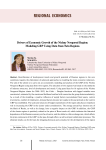
Drivers of Economic Growth of the Nizhny Novgorod Region: Modeling GRP Using Data from Twin Regions
Статья научная
Identification of development trends and growth potential of Russian regions in the new conditions requires the elaboration of advanced approaches to modeling the main economic indicators. The aim of the article is to carry out an econometric modeling and analysis of the GRP of the Nizhny Novgorod Region using data from twin regions. The selection of twin regions was based on the similarity of industry structures, level of development and trends. Using panel data for 16 regions of the Nizhny Novgorod Region cluster for 2000-2023, the Cobb - Douglas functions with lagged variables were constructed, estimated by the maximum likelihood method with correction for group heteroscedasticity. As a result of the modeling, a positive influence of supply factors (accumulated fixed assets, current investments, number of employees), demand factors (income per capita in the past period) on the current GRP was established. The scale and structure of budget expenditures of the region also play an important role in increasing the GRP in the cluster under consideration. The average annual key interest rate of the Bank of Russia, as well as its change, have a negative impact on the GRP. In addition, the GRP of the cluster regions is positively related to the price of Brent crude oil, which indicates the historical dependence of the Russian economy on the oil sector, and the dollar to ruble exchange rate, which affects the price component of the GRP through the pass-through effect, as well as import substitution processes. The obtained results can be the basis for designing forecasts and scenarios for the development of the region in the future, determining the consequences of regulatory impacts at the regional level and the effects of uncontrolled macroeconomic parameters. Further development of the study is possible through the inclusion of high-frequency data, the elaboration of models with more advanced specifications, including structured and aggregated ones, as well as separate modeling of the inflationary and real components of GRP, which together will allow for the creation of more accurate short-term forecasts
Бесплатно
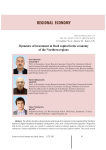
Dynamics of investment in fixed capital in the economy of the northern regions
Статья научная
The article describes characteristics and trends of investment in fixed capital of the Northern regions. It singles out phases of rapid pre-crisis growth, crisis, post-crisis growth and stagnation. Stagnation and decline in recent years are caused by completed major investment projects, reduced own funds of enterprises, limited availability of investment resources and increased capital outflow. The article reveals that the growth of investment in fixed capital of the North in the post-crisis period is provided by the regions, carrying out major investment in oil and gas pipeline transport, oil extraction, production and distribution of electricity, gas and water. The changes in the sectoral structure of investment in fixed capital of the Northern regions are barely visible; the share of investment in the traded sector is still high, especially in mining, due to the Northern regions’ specialization in the extractive industries. The share of investment in the public sector and social services remains low...
Бесплатно
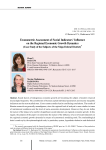
Статья научная
Social factors of endogenous economic growth are becoming the subject of modern research increasingly frequently. The contribution of human capital individual parameters and income inequality indicators are the most studied ones. Cross-country studies lead to conflicting conclusions. The results of Russian research are generally unambiguous, since the regional level of analysis is more similar in terms of institutional conditions and the level of socio-economic development. However, they do not define the nature of the impact of a number of significant social indicators on regional economic growth. In this regard, the purpose of the paper is to determine the nature of the influence of a set of social indicators on the regional economic growth dynamics by means of econometric modeling tools. The methodological basis is made up by the epistemological tools, in particular, system, hypothesis-deductive and dialectical approaches, as well as the methods of content analysis and econometric modeling. The most significant results characterizing the scientific novelty of the presented research include the following: 1) it is determined that the impact of the population's birth rate, mortality and morbidity on GRP corresponds to the nature of the dependencies identified for countries having experienced the second demographic transition; 2) it is established that the character of influence of the indicators of “life expectancy”, and “the number of students studying in bachelor, specialist, master degree programs” and “the number of employees with higher education in the region's economy” on the GRP does not correspond to the trends in developed countries; 3) it is proved that the inconsistency of the obtained results is a consequence of the underestimation of human capital as the main factor in the development of the Russian economy at the present stage; 4) the extent and consequences of the restraining effect of the analyzed social indicators on the dynamics of regional economic growth are determined. Based on the results of econometric modeling, the priorities of regional socio-economic policy for the medium term are identified, depending on the level of their impact. The authors associate the prospects for future research with a deeper study of the impact of life expectancy and mortality factors on the regional economic growth, as well as the verification of this model for the entire set of regions of the Russian Federation.
Бесплатно
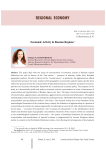
Economic activity in Russian regions
Статья научная
The paper deals with the issues of concentration of economic activity in Russian regions influenced not only by factors of the “first nature” - presence of minerals, fertile land, favorable geographic position, but also by factors of the “second nature”, in particular, the agglomeration effects and potential savings in the scale. Analysis of the geographic concentration and the region-specific focus reflects the general trend in the concentration of industrial production, investment and human resources, provides the necessary information framework for a harmonized economic policy. The purpose for the study is to theoretically justify and analyze economic activity concentration in terms of assessment of concentration and specialization of Russian regions over time. The paper reveals terminological aspects of concentration, agglomeration, specialization, agglomeration economics and urbanization. The applied methodological tools of assessment include the localization factor, Herfindahl-Hirschman and Krugman concentration and specialization indices, Gini index...
Бесплатно

Economic inequality of citizens beyond averages: assessment in the conditions of its transformation
Статья научная
Inequality in Russia has been at a consistently high level for 30 years, but it is not permanent or static. New forms of it are emerging, such as digital inequality, inequality of life and work balance, health inequality, inequality of the coronavirus crisis. The difference between the richest and poorest in food consumption in terms of volume is shrinking, but in terms of quality it is growing. The purpose of the study is to substantiate the need to improve approaches to the measurement of economic inequality of citizens on the basis of determining the features of its modern transformation. The hypothesis of the study is that economic inequality in Russia is transforming, and the existing approaches to its assessment do not allow us to comprehensively and objectively determine its current state, which leads to the ineffectiveness of the measures taken by the government to smooth it out. A comparative analysis of the classical indicators of economic inequality was conducted: the Gini coefficient, the Theil, Atkinson, Palma indices, R/P 10% ratio (the ratio of the average income of the richest 10% to the poorest 10%), R/P 20% ratio (the ratio of the average income of the richest 20% to the poorest 20%), decile differentiation ratio (the ratio of the lowest income in the tenth decile to the highest income in the first decile) and quintile differentiation ratio (the ratio of the lowest income in the fifth quintile to the highest income in the first quintile). The results of the assessment of inequality in Russia obtained by eight organizations (Rosstat, CIS Stat, World Bank, Luxembourg Income Study, Credit Suisse, World Inequality Database, UN Development Program, European Bank for Reconstruction and Development) are compared. In Russia, income inequality remains consistently high, wealth inequality is excessive (Credit Suisse estimates the Gini coefficient at 0.88), and opportunity inequality is less significant in comparison to them. It is proved that the classical statistical indicators do not reflect the transformation of economic inequality, new markers are needed for this. Rosstat estimates income inequality and consumption inequality, leaving out wealth inequality and nonmonetary manifestations of economic inequality. Four directions for improving approaches to the diagnostics of economic inequality in Russia were identified: a qualitative assessment of the manifestations of consumption inequality, nonmonetary manifestations of economic inequality, wealth distribution and the increase in income differentiation within the groups of the wealthiest citizens.
Бесплатно
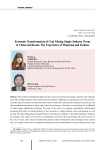
Статья научная
The problem of spatial development does not lose its relevance for large countries such as Russia and China. Single-industry towns deserve special attention. Making up a significant part of the country’s economy, they are subject to numerous risks, many of which have already been realized. In particular, the risks manifested themselves in those cities where the economy is focused on coal mining, the availability of which began significantly reducing. The aim of the work is to propose scientifically substantiated promising directions of transformation of the economy of single-industry towns specializing in coal mining. We chose Pingxiang in Jiangxi Province of China and Vorkuta in the Komi Republic of Russia as examples. The choice of the cities is conditioned by the fact that coal mining will cease in them in the next 15 years. The article retrospectively analyzes their development and investigates their current state. As a result of the work, we proposed directions for the transformation of the economy of the cities under consideration: for Pingxiang, the preservation of industrialization trends, the development of cross-border interregional cooperation between Hunan and Jiangxi provinces in terms of creating logistical infrastructure, strengthening the development of agriculture and creating green infrastructure, ensuring the development of culture and tourism, and modernizing consumption; For Vorkuta, it is the development of the following economic activities: synthesis of artificial diamonds, production of new types of products from coal, extraction of useful elements from overburden dumps, as well as the development of the R&D sector, creative industries and tourism. Scientific novelty of the work consists in substantiating strategic priorities of the development of single-industry towns based on the existing prerequisites and competitive advantages of the territory.
Бесплатно

Evaluating digital ecosystems in Russia's regions
Статья научная
Successful establishment and functioning of the digital economy is possible only in an adequate digital ecosystem, but the semantic and structural content of this system has not been defined adequately yet. Such uncertainty can be found at different levels (federal, regional and local) and in various aspects: subject-related, branch, segment, technical and others. At the same time, the need to implement effective measures for the development of regional digital ecosystems requires not only an understanding of their qualitative content, but also an accurate quantitative assessment. Our paper analyzes conceptual approaches to the definition of a digital ecosystem, provides our own understanding of its full content, which allows us to build a sufficiently verifiable assessment of digital ecosystems development at the regional level. We present a technique for assessing the development of regional digital ecosystems; according to this technique two integrated indices are calculated, and on this basis we carry out an analysis on 82 constituent entities of Russia over the period of two years. The study reveals the existence of significant differentiation between the regions according to the level of development of digital ecosystems; it also helps identify a number of characteristic types of regions in this context. Our assessment has shown that, along with the majority of the regions where the development of digital ecosystems is defined as average, some regions show opposite trends. There are regions, for example, the Belgorod and Kirov oblasts, in which the conditions for the digital environment are below average, but the level of ecosystem development in them is average or higher. There are regions where the situation is the opposite, i.e. the conditions are quite high, but the level of development of the digital ecosystem as a whole leaves much to be desired. Such a negative example is the Moscow Oblast. We also identify leading regions and problem regions. We hope that a reliable assessment of development of digital ecosystems using our technique will help work out effective solutions for successful promotion of the digital economy in Russia.
Бесплатно
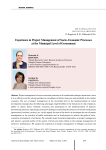
Experience in project management of socio-economic processes at the municipal level of government
Статья научная
Project management of socio-economic processes is of considerable strategic importance, since it is an effective tool for solving problems in conditions of limited resources and instability in the market economy. The use of project management at the municipal level in the implementation of urban development strategies has the following advantages: high flexibility in the formation of a list of projects; ability to choose forms, methods, resources and participants in the implementation of projects; harmonizing interests, organizing constructive dialogue and pooling the resources of various social groups (government, business, society), etc. In this regard, the aim of the work is to investigate the use of project management in the activities of public authorities and its development to achieve the goals of socio-economic development of territories. We consider major theoretical approaches to project management and present a general outline of the system of levels and tools related to the strategic management of territory’s development. We analyze the experience of project management in Vologda and prove the effectiveness of its use in the implementation of territory’s development strategy. In addition, we propose main directions for the application of advanced management technologies - the implementation of project management based on ESG principles. It includes addressing environmental issues (E - environmental), social responsibility (S - social) and personnel governance (G - governance). Analyzing theoretical foundations and Russian experience, we identify directions for the development of project management based on ESG principles, reveal current problems and propose a set of measures for further improvement of project work in the field of public administration in order to address strategic tasks of territorial development. The information base includes the works of Russian and foreign scientists, project management specialists, and data from official websites of Russia’s constituent entities. We use the following methods: analysis, comparison, generalization, sampling and grouping. The scientific provisions set out in the article may be useful to government officials and researchers interested in the implementation and application of project management.
Бесплатно
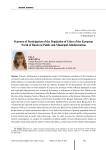
Статья научная
Citizens’ participation in managing the country’s development contributes to the formation of civil society and acts as a key element of democracy. In Russia, where three-quarters of the population are urban residents, it is especially important to study these issues in relation to cities, so as to understand the processes taking place in society and work out effective strategies for its development. The aim of the work is to consider ways in which residents of cities in the European North of Russia participate in state and municipal administration and to identify its features in settlements of different sizes. Based on the data of the Central Election Commission of the Russian Federation we analyze the turnout of residents of 68 cities of the European North of Russia for the presidential election of the Russian Federation (2018) and the election to the State Duma of the Federal Assembly of the Russian Federation (2021). We also assess the level of voter support provided to President Vladimir Putin and the United Russia party. It is revealed that the electoral activity of residents is determined to a greater extent by the peculiarities of the structure of the city’s economy rather than the size of the city. Based on the analysis of the results of voting for the choice of urban improvement objects, it was found that residents of sparsely populated cities are more motivated and involved in these processes. We also find out that territorial public self-government is most actively used in small, rather than large, cities. In order to assess the informal mechanisms of citizens’ participation, we analyze the availability of official profiles of local self-government bodies on VKontakte social media and the number of their subscribers, as well as data on the number of participants in informal urban communities. We have revealed that this method of communication with the authorities is mostly used by residents of small settlements. Scientific significance of the study lies in determining the features of dissemination of various mechanisms of civic participation, depending on the type of city. Practical significance lies in the possibility of using our findings by the authorities in improving the policy of involving citizens in management processes.
Бесплатно
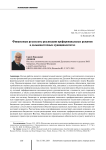
Статья научная
The aim of the work is comparative analysis of the problems and methodological approaches to assessing financial effectiveness of measures implemented in the Far East in the context of regional preferential policy in outstripping development territories (ODTs) and in the Free Port of Vladivostok (FPV). We analyze the experience of organizing preferential regimes in ODTs and FPV, substantiate the reasons for difficulties in assessing the implementation of financial measures of preferential regimes related to the political specifics of the implementation of the latter; difficulties in clustering the objects of analysis due to a considerable differentiation of Far Eastern municipalities; difficulties related to the assessment horizon; as well as current problems concerning the substantiation of indicators to comprehensively assess the results of stimulating municipal development. We show how local budgets are affected financially by the extension of local preferential regimes to the entire territory of the Far East and the prerequisites for the emergence of a “tax trap” as a result. Using the example of the Khabarovsk Territory, we assess shortfall in local budget revenues caused by a significant increase in tax benefits. We reveal the consequences of a situation when the volume of tax benefits provided is not limited by the volume of investments in projects. We consider measures to dampen the consequences of the “tax trap” for regional budgets in the case of expanding the zone of local preferential regimes to the entire Far East. We propose to allocate tax benefits to a resident in the form of a money grant, provided that the resident fulfills its obligations to increase employment and develop the real sector of the region's economy, and the total amount of benefits is limited by the amount of investments made by the resident.
Бесплатно
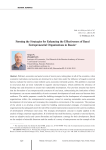
Статья научная
Political, economic and social events of recent years, taking place in all of the countries, when economic institutions and systems are destroyed in a short time under the influence of negative external factors, indicate the need to create resilient socio-economic territorial systems. This problem is essential to rural areas that are most vulnerable to negative external impacts, which confirms the relevance of finding ways and directions to ensure their sustainable development. Our previous research has shown that the formation of an entrepreneurial ecosystem of rural areas, substantiating the institutions of their development, can ensure sustainability of socio-economic development of rural areas and increase their resilience. The article proposes a model for building strategies for the development of entrepreneurial organizations within the entrepreneurial ecosystem, aimed at ensuring sustainable socio-economic development of rural areas and increasing the competitive environment of the ecosystem. The purpose of the article is to develop a factor model for building entrepreneurial strategies of entrepreneurial organizations that adequately meet the role of the rural entrepreneurial ecosystem in the current conditions of development of Russian rural areas. The strategic development concept is usually applied in the analysis of large corporate organizations. It is believed that small businesses, exposed to external factors, must use adaptive tactics and cannot formulate and implement a strategy for their development. Based on the analysis of scientific literature and the results of a survey of entrepreneurs on the example of the Sverdlovsk Oblast of the Russian Federation, we found that rural entrepreneurs seek to determine strategic directions of their development. The article presents approaches to the disclosure of relevant factors that determine the model for choosing a development strategy for rural entrepreneurial organizations. The information base of the study includes research works of Russian and foreign scientists on the topic under consideration, as well as the results of a thematic survey. The scientific novelty of the work lies in the fact that for the first time an attempt has been made to build a factor model for strategic development of rural entrepreneurs within the concept of entrepreneurial ecosystem of rural areas.
Бесплатно
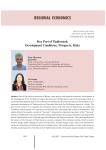
Free port of Vladivostok: development conditions, prospects, risks
Статья научная
One of the priority directions of Russia's state policy with regard to territories' development is the development of the Far Eastern region. The free port of Vladivostok is one of the key projects that are currently being implemented in the southern part of Primorsky Krai and they focus on boosting the socio-economic development of Vladivostok city, Primorsky Krai and the Far Eastern region as a whole. The goal of this research is to consider the conceptual issues of the free port of Vladivostok, to outline the conditions and prospects of its operation and identify risks associated with its future development. The article defines the modern concept of “free port”, characterizes historical experience of the “free port” regime in Vladivostok in the end of the 19th century, substantiates the strategic importance of using the free port of Vladivostok as a tool of intensive growth of Russian Far Eastern territories. The article also discloses the essence of the free port of Vladivostok as a means to promote free entrepreneurship, which is used to increase freight traffic through the port of Vladivostok, increase foreign trade, attract new investments, create new industries and develop the port's infrastructure...
Бесплатно
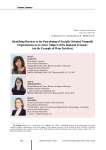
Статья научная
Due to the difficult socio-economic situation of Russia’s regions, it is necessary to involve nongovernmental providers of socially significant services to eliminate government failures. In this regard, socially oriented nonprofit organizations play an important role. As practice shows, despite the recognized importance of such organizations, their potential in the regional economy is not implemented to the fullest extent. Reasons for such a situation are studied in a large number of works, but they do not always take into account territorial specifics, which makes it difficult to identify specific areas of problem solving. Thus, the aim of this study is to identify barriers to and prerequisites for the sustainable development of socially oriented nonprofit organizations as an active subject of the regional economy, effectively implementing its functions in socially significant sectors of the economy on a systematic and long-term basis. To achieve this goal, we analyze the functioning of socially oriented nonprofit organizations (using the example of Perm Territory). The information base includes a set of relevant regulatory documents, data from state and departmental statistics, ratings of RF constituent entities, findings of sociological research commissioned by the Grants Fund of the Governor of Perm Territory in 2020-2022. We systematize the problems that socially oriented nonprofit organizations deal with in their work, according to the impact on the organization, respectively, related to the external and internal environment. On this basis, we outline the conditions necessary to increase the sustainability of the development of socially oriented nonprofit organizations in the region.
Бесплатно

